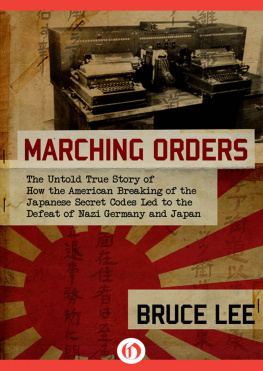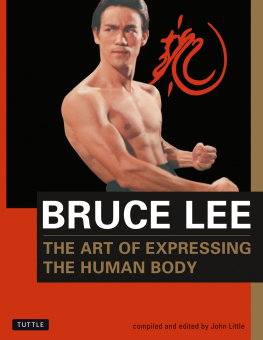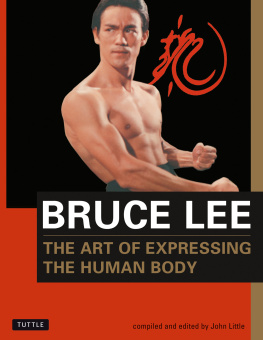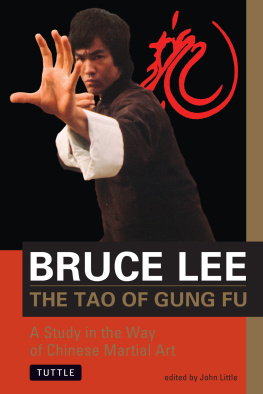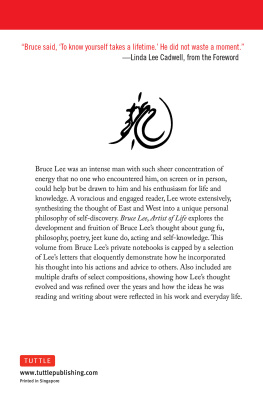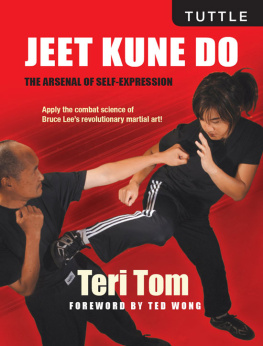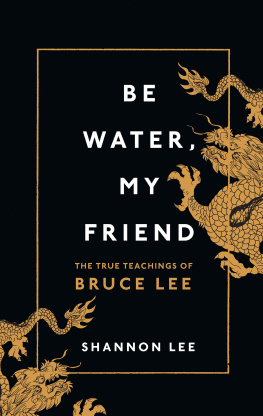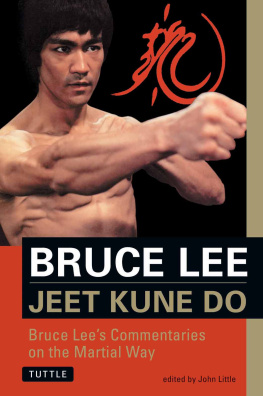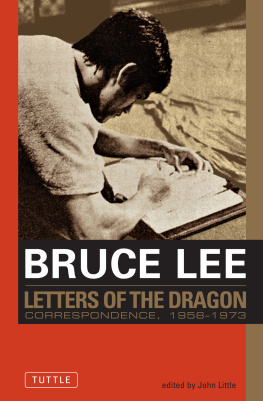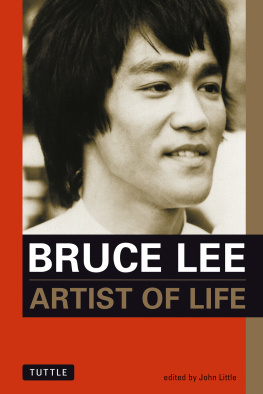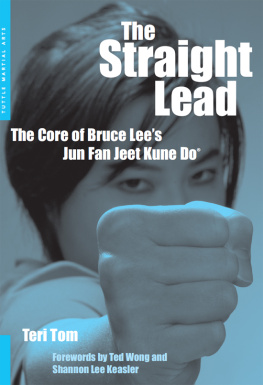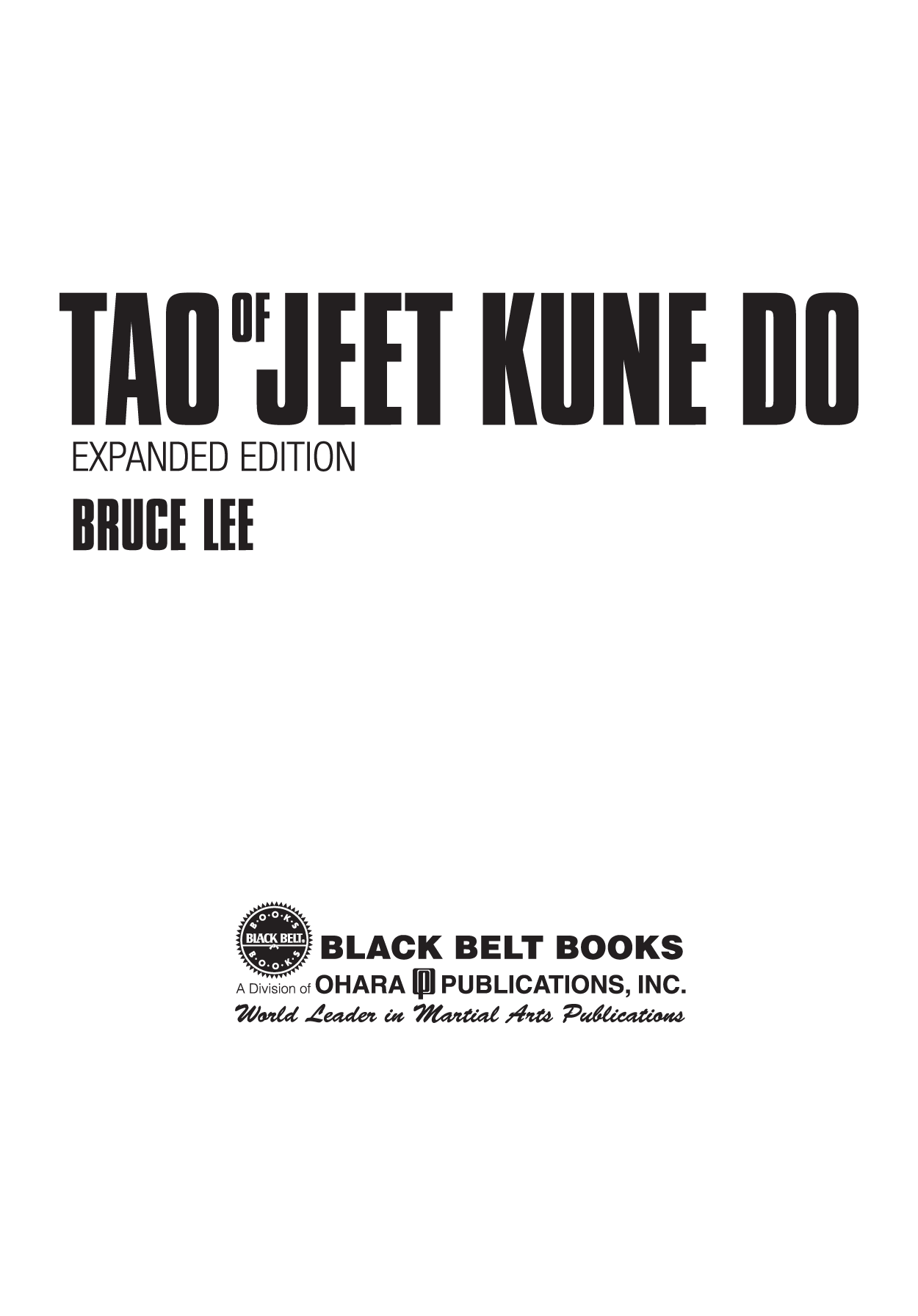

Black Belt Books, Valencia CA 91355
Copyright 1975, 2011 Bruce Lee Enterprises LLC
BRUCE LEE , the Bruce Lee likeness, quotes of Bruce Lee and all related indicia are trademarks and copyrights of Bruce Lee Enterprises LLC. All Rights Reserved. brucelee.com
Originally Edited by Linda Lee Caldwell and Gil Johnson
Originally Translated by David Koong Pak Sen
Project Supervision by Shannon Lee
Edited by Kris Storti, Sarah Dzida, Atina Hartunian, Jeannine Santiago
Additional Translation by Eric Chen
Design by John Bodine
Original illustrations by Bruce Lee
Warning: This book is presented only as a means of preserving a unique aspect of the heritage of the martial arts. Neither Ohara Publications nor the author make any representation, warranty or guarantee that the techniques described or illustrated in this book will be safe or effective in any self-defense situation or otherwise. You may be injured if you apply or train in the techniques illustrated in this book and neither Ohara Publications nor the author is responsible for any such injury that may result. It is essential that you consult a physician regarding whether or not to attempt any technique described in this book. Specific self-defense responses illustrated in this book may not be justified in any particular situation in view of all of the circumstances or under applicable federal, state or local law. Neither Ohara Publications nor the author make any representation or warranty regarding the legality or appropriateness of any technique mentioned in this book.
DEDICATION
This book is dedicated to the free, creative martial artist: Research your own experience; absorb what is useful, reject what is useless and add what is essentially your own.
INTRODUCTION (1975)
Linda Lee
My husband Bruce always considered himself a martial artist first and an actor second. At the age of 13, Bruce started lessons in the wing chun style of gung fu for the purpose of self-defense. Over the next 19 years, he transformed his knowledge into a science, an art, a philosophy and a way of life. He trained his body through exercise and practice. He trained his mind through reading and reflection, and he recorded his thoughts and ideas constantly over those 19 years. The pages of this book represent a look into his lifes work.
In his lifelong quest for self-knowledge and personal expression, Bruce was constantly studying, analyzing and modifying all available, relative information. His principle source was his personal library, which consisted of over 2,000 books that dealt with all forms of physical conditioning, martial arts, fighting techniques, defenses and related subjects.
In 1970, Bruce sustained a rather severe injury to his back. His doctors ordered him to discontinue the practice of martial arts and to remain in bed to allow his back to heal. This was probably the most trying and dispiriting time in Bruces life. He stayed in bed, virtually flat on his back for six months, but he couldnt keep his mind from workingthe result of which is this book. The bulk of these writings was done at this time, but many scattered notes were recorded at earlier and later times. Bruces personal study notes reveal that he was particularly impressed by the writings of Edwin L. Haislet, Julio Martinez Castello, Hugo and James Castello and Roger Crosnier. Many of Bruces own theories are directly related to those expressed by these writers.
Bruce had decided to finish this book in 1971, but his film work kept him from completing it. He also vacillated about the advisability of publishing his work because he felt it might be used for wrong purposes. He did not intend it to be a how to book or a learn kung fu in 10 easy lessons book. He intended it as a record of one mans way of thinking and as a guide, not a set of instructions. If you can read it in this light, there is much to be aware of on these pages. You probably will have many questions, the answers you must seek within yourself. When you have finished this book, you will know Bruce Lee better, and hopefully, you will also know yourself better.
Now open your mind. Read. Understand. Experience. And when youve reached that point of understanding, discard this book. The pages are best used for cleaning up a mess, as you will see.
Gilbert L. Johnson
In the hands of a singular man, simple things carefully placed ring with an undeniable harmony. Bruce Lees orchestration of martial arts had that quality, which was most apparent in his combat motion. Immobilized for several months with an injured back, he picked up a pen. There, too, he wrote as he moved and as he spoke: with directness and with honesty.
Like listening to a musical composition, understanding the elements within it adds a specialness to the sound. For this reason, Linda Lee and I are liberalizing the introduction of Bruces book by offering some insight into it in order to explain how it came about.
The Tao of Jeet Kune Do actually began before Bruce was born. The classical wing chun style that started him on his martial way was developed 400 years before his time. The 2,000 or so books he owned and the countless books he read described the individual discoveries of thousands of men before him. Theres nothing new within this book; there are no secrets. Its nothing special, Bruce used to say, and so it isnt.
Bruces special ability, his personal key, was knowing himself and his own capabilities to correctly choose things that worked for him and to convey those things through movement and language. He found an organization for his thoughts in the philosophies of Confucius, Spinoza, Krishnamurti and others, and with that organization, he began the book of his TAO.
Unfortunately, the book was only partially completed when Bruce died. Though it spanned seven volumes, it filled only one. Between major blocks of copy were unnumbered pages of unused paper, each headed by simple titles. Sometimes, Bruce wrote introspectively, asking questions of himself. More often he wrote to his invisible student, the reader. When he wrote quickly, he sacrificed his practiced grammar, and when he took his time, he was eloquent.
Some of the material within the volumes was written in a single sitting and had the natural progression of a well-outlined conversation. Other areas were sudden inspirations and incomplete ideas that were quickly scribbled as they entered Bruces head. These were scattered throughout the work. In addition to the seven hard-bound volumes, Bruce wrote notes throughout the development of his jeet kune do and left them in stacks and drawers among his belongings. Some were outdated. Others were more recent and still valuable to his book.
With the help of his wife Linda Lee, I collected, scanned and thoroughly indexed all the material. Then, I tried to draw the scattered ideas together into cohesive blocks. Most of the copy was left unchanged. The drawings and sketches are Bruces own.
The books organization, however, could not have been justly done were it not for the patient attention of Danny Inosanto, Bruces assistant instructors and class of senior students. It was they who took my eight years of martial arts training, threw it out on the floor and turned the theories into action with their knowledge. They have my gratitude both as the editor of this book and, separately, as a martial artist.
It should be mentioned that the Tao of Jeet Kune D o is not complete. Bruces art was changing every day. Within the section on the Five Ways of Attack, for instance, he originally began with a category called hand immobilization. Later, he found that too limiting as immobilizations could be applied to the legs, arms and head, as well. It was a simple observation that showed the limits of attaching labels to any concept.
Next page

